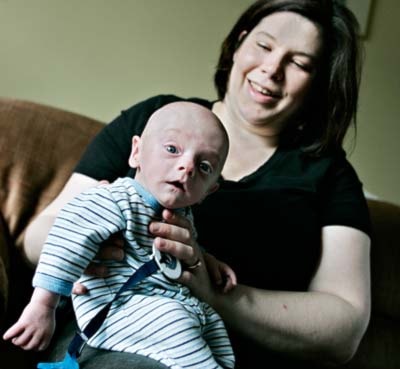Micah McPhee howls for another feed of soy formula from his burp-free bottle.
“There were a couple of times when the nurses said he shouldn’t be eating as much as he was, but he would just chow down,” recalls his mother, Araica, who spent seven weeks with her baby in a British Columbia neonatal intensive care unit.
At four months of age, having tripled his birthweight, Micah now weighs 7.5 pounds.
“I have a picture of him and his head was the size of a hockey puck,” laughs his cheerful mom, adding it was the idea of dad Glenn, to use such a gauge of reference.
As a type 1 diabetic, a two-pound, five-ounce babe was not what Araica was expecting.
She had always been warned about the bruiser her condition could produce: it was possible she was incubating a 10-pounder, some predicted.
But at 28 weeks, the fetus stopped growing, due to a complication, sometimes diabetes-related, known as intrauterine growth restriction.
By the time his mother was medevaced to BC for an emergency caesarian section at 33 weeks, Micah was in serious distress.
He came into the world famished.
“They said that’s typical of IUGR babies,” says Araica. “I don’t know if it’s just that they come out hungry, or they come out fighting, or what. Maybe it’s just a really strong survival instinct. Who knows? But it’s good.”
Often characterized by their wide eyes, IUGR babies do not receive adequate oxygen and/or nutrition via the umbilical cord.
At birth, they have more skin than appears necessary to encase their tiny frames, and their umbilical cords are thin and, occasionally, somewhat flat.
Diabetes is high on the list of culprits that can cause IUGR, a condition that can indicate infection, birth defects or chromosomal abnormality in the affected child.
“We got off lucky with him,” says Araica.
So far, aside from being hungry, Micah’s only complications appear to be a slight deficiency in cortisone production from his adrenal gland, some acid reflux, and a bit of excess gas that may be the cause of his nighttime cranky spells, a condition his mother remedies by carrying him in a belly pouch while she carries on with work and play.
“It’s interesting,” says Araica, who is back at work as a mortgage broker while her husband is on parental leave. “I thank God I’m on an insulin pump. I don’t think I’d survive, with my schedule, if I wasn’t. Lack of sleep can muck me up for a good 24 hours the next day.”
For the reflux, Micah takes two daily doses of Ranitidine, an acid inhibitor and the same drug his father has taken in the past for the same complaint.
During her pregnancy, Araica’s complaints were far greater in number and variation.
“Compared to a lot of people, I’m sure it was fine,” she says. “I wasn’t a very happy pregnant lady. I think because it was so intense, all the things I had to really pay attention to and keep track of.”
Although tight control of blood sugar levels is essential to the health of any diabetic, it is of crucial importance during pregnancy.
Blood sugar fluctuations can adversely interfere with the development of the organs and spine, which takes place in the first two to three months of gestation.
But after trying for six years for a baby, the McPhees knew they were expecting at five weeks.
The early knowledge was helpful in keeping blood sugar levels fairly steady, says Araica.
But it was not always easy.
Diagnosed with type 1 diabetes only 10 years ago, Araica has had difficulty at times reconciling cyclical hormonal fluctuations with blood and insulin levels.
Adding pregnancy to the formula created new challenges.
At the end of trimester three, a diabetic woman will often be consuming up to three times the insulin required on average during her nonpregnant state, and sugars can peak and dive with hormonal changes and other forms of stress.
Then there were the fetal echocardiograms and weekly ultrasounds.
Technicians told her long before the emergency delivery that a medevac was a likelihood.
“They (the IUGR babies) are more likely to have things go wrong,” she explains. “They want to be on the cautious side. I would way rather be overcautious.”
The time spent with Micah in neonatal intensive care was not fun, says Araica.
“But I sometimes think I learned more from those nurses in that seven-week period, and I came home with this four-and-a-half-pound baby, and I felt pretty confident about it.
“All these different nurses who had five to 50 years of experience behind them taught me all the tips and tricks and walked me through everything. I definitely felt a lot more confident, coming home.”
This weekend, Micah, whose growth and weight gain are on par with babies his gestational age, will be joining his parents and grandparents on his first camping trip in the motorhome.
They will be back in Whitehorse for Sunday.
The Telus Walk to Cure Diabetes begins Sunday at 1 p.m. at Shipyards Park. Registration begins at 11 a.m.
